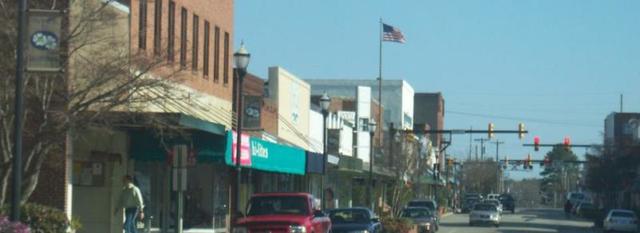LAURINBURG — City officials checked in with representatives of the N.C. Main Street Center on Tuesday to gauge the city’s progress in reaching an understanding of downtown Laurinburg’s assets and how it can best function relative to the regional economy.
The city became part of the center’s Downtown Associate Community program last year, putting it in the running for full Main Street membership in the coming years.
“This planning process is essentially a three- to five-year planning process, then we’re going to come in and define out with you a one-year plan of work so that you can implement the plan and you can measure the outcome,” said center director Liz Parham.
This week’s meeting was the third quarterly visit by center staff to Laurinburg to guide the city through the process of asset mapping, evaluating strengths and weaknesses, and identifying the roles of current and potential partners among businesses and organizations in the city.
“When we look at economic development, no matter what type of economic development … you’re looking at these components,” said Parham. “You’re looking at leadership, quality of life, you’re eventually recruiting new businesses. It’s sort of a bottom-up approach.”
Pointing out that the Main Street program focuses on economic development within the context of historic preservation, Parham flashed slide of the Market Furniture building at the corner of Main and Railroad streets — noting that kind of structure should be viewed as an opportunity rather than a liability.
The property and business inventories furnished by the city will be transformed into a downtown database to make readily available information from the square footage and value of commercial properties to the number of benches and trees downtown.
That information in turn will better enable the city to define a role for downtown that is cohesive with economic drivers in the area.
“Economic drivers are much bigger than downtown: they could be citywide, they could be countywide, they could be regional, but they really are the reasons that people come to your community to live, to work, and to play,” said Parham.
Among established Main Street communities, Garner chose to let sports and recreation facilities guide the trajectory of downtown growth, and Albemarle has modeled itself as a gateway to the Uwharries.
“They’re building a downtown around healthy living, arts, and entertainment and a pathway to recreation opportunities,” Parham said. “Those are important transformative economic development strategies. So again, what is transforming your downtown? What do you have the opportunity to tap into to transform your downtown?”
During Tuesday’s public presentation, Leroy McIntyre brought up the subject of combating public perception and convincing former and existing players to adapt to a new process.
“After we get this all done, does that automatically mean that it transforms people’s attitudes and behaviors so they radiate something that makes outsiders want to be a part of the area?” he said.
“I think the key thing is the way you make them feel in the process. If I feel that I’m going to contribute this and this is going to make me stand out better in the community and I’m going to be recognized as a result of contributing this, I think you’ll get so much more buy-in from everybody.”
Parham encouraged those present to consider the program, which ultimately will provide opportunities for public participation on every scale, as a chance to invite people to be more involved.
“Most of the time, when people have negative attitudes or they’re not involved in something, it’s because they don’t know how to be involved, they don’t understand what’s going on, or they simply haven’t been asked,” she said.
Mary Katherine Murphy can be reached at 910-506-3169.

